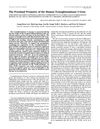Dissection of a Complex Enhancer Element: Maintenance of Keratinocyte Specificity but Loss of Differentiation Specificity
June 2002
in “
Molecular and Cellular Biology
”
TLDR Keratinocyte gene expression is controlled by multiple modules with specific binding sites.
The study investigated a complex enhancer element involved in keratinocyte specificity, revealing that while the enhancer maintained its ability to target keratinocytes, it lost its differentiation specificity. This suggested that the enhancer could still direct gene expression to keratinocytes but was unable to distinguish between different stages of keratinocyte differentiation. The research provided insights into the regulatory mechanisms of gene expression in skin cells, highlighting the complexity of enhancer elements in maintaining cell-type specificity while potentially losing differentiation cues.
